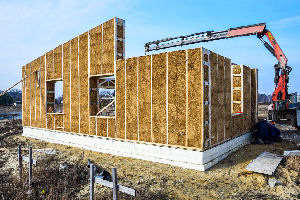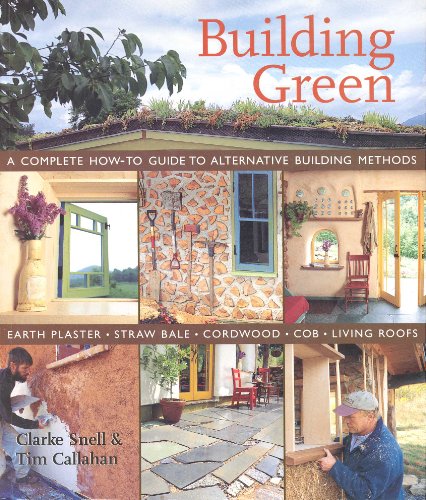
Green Building Materials
Green Building Materials

Green Building (also known as green construction or sustainable building) relates to alternative energy in terms of being friendly to the environment. It basically consists of constructing buildings that are environmentally sound and more energy efficient.
But green building design is not just about using energy, water and other resources more efficiently, its more about reducing carbon consumption, construction waste, and less use of toxic materials.
Green building designs have the potential to enhance a buildings life-cycle by careful selection of its site, design, construction, and operation. Architects and builders have found new renewable energy technologies and construction materials both limiting and reducing the ecological impact of a building on the environment. Good passive solar design lets the sun’s energy flow into a building, heating and lighting it in an energy efficient way.
Green Building Concept

The green building concept is not about ecohouses, living roofs, double glazing, or turning down the thermostat a few degrees. But simply to design and construct a building which conserves the planets natural resources, generates less waste, while at the same time provide a healthier and comfortable living space compared to a more conventional building.
Residential green buildings have been steadily evolving over the past few decades or so. Green building is used in connection with environmentally sustainable building materials and practices. Today, better heating, better insulation, more efficient electrical appliances, LED lighting and other structural elements reduce the overall impact of a building on health and the natural environment.
Green buildings achieve many other goals other than just energy efficiency. For example, using natural materials in their construction can reduce the level of harmful toxins, gases and other such substances in a building, such as adhesives, glues, paints or fiberglass insulation. Substituting these materials for natural products such as recycled paper, cork, bamboo, reclaimed wood, etc. can contribute to the lessening of pollution, landfill, and/or energy consumption. After all, the more we use non-renewable products, the more pollution we create.
Then buildings can have a large effect on the environment, human health and ecological impact. The manufacturing, design, construction and operation of a building is responsible for the consumption of our natural resources. But by reducing waste, pollution and environmental degradation we can make buildings more “green” and “sustainable”.
Environmental Benefits of Green Buildings
The benefits of using green building materials can maximise both the economic and environmental performance of a building. Whether planning a new building project, retrofitting or repairing an existing one, there are many areas of improvements we can use with building materials and energy conservation in mind. Homeowners, builders and constructors can all increase their sustainability goals by using green materials.
The environmental benefits of green buildings starts with the following three actions: Reduce, Reuse, and Recycle. These include:
- Efficient use of Resources during Construction
- Reduction in Carbon Consumption and Waste
- Reduced Energy Consumption and Life-cycle Costs
- Extensive use of Renewable Energy Technology
- Preserve Natural Resources and Systems
- Improve Air and Water Quality inside the Building
- Reduce use of non-toxic Materials
- Protect Local Ecosystems by Reducing Ecological Footprint
Nowadays, many towns and cities around the world have green building programs and initiatives to reduce a construction’s environmental impact. Reducing greenhouse gas emission during construction and extensive use of nonrenewable materials help a building to reach carbon neutrality during its lifetime.
But green or sustainable building construction is not all “green” and perfect. While going “green” maybe the right thing too do, the initial high cost of construction of 10% to 40% more than conventional building, non-availability of suitable materials, an increase in construction time, as well as a need for skilled or trained workers to build it, can be a disadvantage to many looking at a green home future.
Not so long ago, there was a lack of green building materials on the market. Today, the number and amount of products available is expanding all the time, not only changing the way we build but the materials we build with. The following list gives a selection of the more common building materials available.
Green Building Materials Available
- Structural Insulated Panels – While structural insulated panels are not a new type of technology, but they are popular as an alternative to conventional wood frame construction. These panels can be custom fabricated individually for each project, making for an easier building design and construction. They also provide insulating values as high as R-45, depending on the thickness of the panel, by using polyurethane foam or compressed straw between the panels. Structural insulated panels are airtight, and make a building more comfortable and energy efficient.
- Straw Bales – Bales of straw staked together are another common green building material used in home construction. The building is constructed using traditional framing methods and the space is filled with bales of straw rather than conventional nonrenewable fiberglass insulation.
Straw bale construction provides good insulation and thick walls resulting in deep windowsills. As well as warmth, straw bales also act as a good sound insulator from external road noise. The main disadvantage is water penetration of the straw bales which can cause a buildup of condensation, rot and deterioration. - Bamboo – Bamboo is relatively new to green construction. The sustainable plant grows fast and has little of no negative impact on the environment. Bamboo is stronger than steel and concrete, with bamboo poles fixed together in a similar way to wooden structures creating a stable structure. As well as walls, bamboo can be used to create beams, trusses and coverings. Buildings constructed from bamboo are not only beautiful but are also cost effective and beneficial to climate change reduction.
- Recycled Cork – Recycled cork waste is an energy-efficient thermal insulation material which can also be used for the sound proofing of rooms. Recycled cork and cork waste is a natural, renewable and relatively cheap construction material. No toxic gases are produced when made into floor tiles or wall panels which themselves can be stained, painted or dyed into any colour of choice. Cork is naturally waterproof but can be flammable at high temperature.
- Non-VOC Products – Paints, varnishes, wood preservatives, waxes contain volatile organic compounds (VOCs) which emit harmful indoor fumes and gases. Household products containing VOC may have short or long term adverse health effects in indoors once applied. VOC emissions also contribute to atmospheric degradation and climate change. Non-VOC products reduce the environmental impact of buildings by eliminating toxic ingredients increasing environmental and human health protection.
- Reclaimed Wood – Instead of exploiting depleted natural resources like trees and forests, wood reclamation yards are now becoming more common. Green and eco-friendy designers, builders and architects are starting to use more reclaimed materials in their constructions, increasing the buildings sustainability.
Recycled wood and lumber can not only be used for timber frame construction, as salvaged wood tends to be harder than new wood because it derives from older trees, but can be used in flooring and carpentry. The recycling of wood, lumber and wood waste reduces the cost of new materials, construction, and the consumption of natural resources. Recycled wood also decreases deforestation and the demand for more exotic timber.
A New Age for Construction
Green or sustainable building is about climate-responsive building in both building design and construction. Green builders, architects and designers are consistently searching for sustainable construction methods and products with green building materials used to significantly cut an energy consumer’s bills, reduce pollution, and help safeguard the worlds natural resources.
Energy efficient windows, environmentally friendly materials, man-made and engineered products, are redefined a buildings construction by promoting sustainability and low toxic emissions. Active and passive solar energy, water conservation, waste reduction goals, and the use of green building materials and technologies are now commonplace.
Although building green can be costlier upfront compared to a more traditional construction. Building green will pay off in the long term, saving homeowners money by reduced replacement costs, greater energy efficiency, higher building performance and durability. Energy Star rated appliances are now standard in many homes.
Green Building Summary
We have seen here in this energy articles tutorial about “Green Buildings”, also known as sustainable construction or green architecture design, that the main objectives of green buildings are efficiency and a reduction on the negative impact a building can make on the environment and human health while providing a healthy, and efficient space to live and work in.
Green buildings reduce the harmful effects of pollution and waste and are constructed with materials that require less energy to produce while reducing energy consumption over the building’s lifetime. They are designed and constructed to use more renewable energy and less nonrenewable energy, more recycling and less wastes sent to landfill. Green building materials are environmentally friendly and manufactured locally to the building site while avoiding harmful and toxic materials and chemicals helping to build sustainability.
An effective green building design can use the orientation and natural light through windows and wall placements to increase energy efficiency as well as views of the natural surroundings. Fresh air circulation and good air quality through ventilation inside while garden plants, landscape and green spaces in their design help promote health and well being outside.
Green buildings both residential and nonresidential combine many practices, skills, and techniques to reduce the impact of a building on the environment and human health. To learn more about “Green Building Materials and Construction”, or to understand what green buildings are, or to just explore the advantages and disadvantages of green building design, then Click Here to get your copy of one of the top books on green building design direct from Amazon today.











We do really love Net Zero Energy Tutorial, and will publish some good articles in our website:aluminumsolarframe. com
There is a product- Agrocrete by GreenJams, check it out! It is carbon-negative and sustainable. Would be great if more people get to know about that too!
Thank you for such an interesting article. My husband and I built our home many years ago in Idaho using green and recycled products and used straw for insulation. The dumpster was a good source of materials.